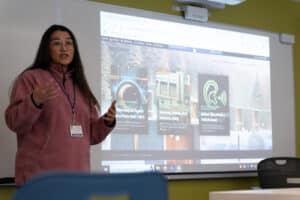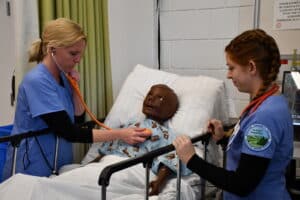Berkshire Community College (BCC) serves students in the rural western part of Massachusetts — one of its most economically disadvantaged regions in the commonwealth. The only open access institution available to residents in Berkshire County, BCC has a student enrollment of roughly 2,000, with nearly half of its students receiving Pell grants and approximately half self-identifying as first-generation students. The last ten years have seen an increase in diversity, with the percentage of students of color rising from 18.4% to 30.7%.
BCC joined ATD in 2021 as one of seven colleges composing the Building Resiliency in Rural Communities for the Future of Work cohort. Through this initiative, the colleges have focused on preparing and connecting students to careers in the digital economy, identifying and closing equity gaps, developing and strengthening community partnerships, and fostering a culture of evidence.
BCC became an ATD Leader College in 2025.
We recently caught up with Dr. Liza Dister, assistant dean of strategic initiatives and student success; Dr. Laurie Gordy, vice president of academic affairs; and Adam Klepetar, vice president of student affairs and enrollment management, to find out how the college is strengthening its role as a rural anchor institution — advancing student success, embedding digital skills across the curriculum, using data to drive innovation, and partnering with employers and organizations to meet the evolving needs of its students and community.
Q: Berkshire Community College was recently awarded Leader College status, in part, for its student success strategy focused on improving first-year retention and gateway course completion. Could you briefly describe the key elements of your approach?
Liza Dister: Sure. At BCC, our strategies focus on four key areas: 1) first-year experience improvements, 2) gateway course curricular reform, 3) investment in student success supports, and 4) financial support enhancements.
To help streamline the first-year experience, we redesigned student service spaces through the One Stop Student Success Center and a self-service portal. Each term, approximately 96-98% of students report that they are satisfied with the services they receive through the One Stop, so that team is doing excellent work.

BCC student Zarina Dyussen presents on Scholar’s Day.
Laurie Gordy: I’d add that in 2024-2025, we took another step by adding digital coaches to the One Stop Center during heavy registration periods. These coaches help students navigate our learning management system and digital tools, making the transition to college smoother.
Adam Klepetar: Additionally, we introduced an online, asynchronous orientation with six modules covering essential topics. Our ATD coaches helped us focus on exploring the differences and similarities between coaching and advising, and we ultimately blended these two groups, which enhanced the orientation and ongoing early support to students.
Laurie Gordy: We’ve also introduced learning communities that pair first-year courses with high-impact practices (HIPs), like collaborative assignments and community-based learning. Faculty professional development has been key as well, focusing on retention strategies such as inclusive pedagogy and metacognition.
When it comes to gateway course reform, we have recently built on the success we saw with adoption in 2017 of a co-requisite model for English, which improved completion rates — especially for Black and Hispanic/Latinx students. Based on data showing disproportionate Accuplacer outcomes, we made a bold move in 2024-2025 to eliminate developmental English. Now, all students have direct access to college-level composition, and our Writing Center has expanded support, including support for multilingual learners.
Liza Dister: In terms of student supports, we’re committed to wraparound advising and coaching services through the SUCCESS (Supporting Urgent Community College Equity through Student Services) program, ensuring historically marginalized students get the support they need. We also leverage EAB Navigate and AI-powered EdSights to proactively address student needs, which has been a game changer for persistence and retention efforts.
Laurie Gordy: And, to improve financial supports for our students, BCC faculty increased their usage of Open Educational Resources (OER) resulting in savings of $337,000 for students in the 2022-2023 Academic Year. The College’s Division of Teaching and Learning provided professional development and stipends to encourage faculty to adopt low or no-cost textbooks. In addition to saving money for students, the increased usage of OER materials improved students course success rates especially for students of color who saw significant decrease in the DFW rates.
Liza Dister: After we implemented some of these initiatives, the College experienced a 14.1 percentage point increase in first-year retention and saw narrowed equity gaps between white students and students of color — especially for Hispanic/Latinx students, whose retention rates improved by 29 percentage points from the 2019 to 2022 cohorts — and between non-Pell recipients and Pell recipients, whose retention rates improved 22.9 percentage points from the 2019 to 2022 cohorts.
Q: Through its participation in ATD’s Building Resiliency in Rural Communities for the Future of Work initiative, BCC has prioritized digital skills development. How is the college identifying and addressing gaps in students’ digital skills, and how has your approach to embedding digital skills evolved over the past few years?
Laurie Gordy: BCC’s work with digital skills began, interestingly enough, in the Liberal Arts program, where faculty developed a campus-wide framework and integrated digital portfolios into coursework. This foundation led to a broader institutional focus, including faculty development around AI. A team of five, including three faculty members, participated in the AAC&U Institute on AI and Pedagogy and have since led professional development sessions on ethical AI use, enhancing case studies, and designing assignments that foster digital literacy. We’ve also provided faculty with the book Teach with AI to deepen their engagement with these tools.

BCC nursing students practice their skills in the simulation lab.
As the result of our work with ATD on digital skills, BCC has embedded digital skills into both credit and non-credit programs. Our strategic plan explicitly prioritizes expanding digital literacy, and two staff members are developing interactive resources to assess student needs and provide targeted support. Additionally, as we revise our General Education Outcomes, we’re ensuring that information literacy and digital skills remain a key proficiency for all students.
Q: One of the goals of the Rural Resiliency initiative is to foster a culture of evidence. Can you share an example of how data has informed a decision or sparked an innovation at BCC that has improved outcomes for your students or community?
Liza Dister: Definitely. One example is our Disability Resource Center, which identified an increase in students facing executive function challenges. As a response, we introduced Glean note-taking software, and 93% of users reported that this helped to improve their grades.
Laurie Gordy: I would also point to the college’s tracking of progress since 2014 through the Survey of Entering Student Engagement (SENSE), a nationwide survey run by the University of Texas at Austin that asks new students questions about their early experiences with the college. The results have guided our improvements in high-impact practices and early student support. These efforts have led to significant gains in student engagement benchmarks, including early connections, clear academic plan and pathway, engaged learning, and academic and social network.
Q: Rural community colleges often serve as critical economic and workforce hubs for their regions. How is BCC partnering with local employers and community organizations to align programs with workforce needs?
Laurie Gordy: Based on strong external partnerships with the local community and internal partnerships between Workforce and Community Education (non-credit programs) and Academic Affairs (credit-bearing programs), BCC has taken some exciting steps in this area. We’ve revitalized programs to meet employer demand, such as our Respiratory Care A.S. program, and developed others, like a certificate program in Water Quality Management. Our Workforce and Community Education division also launched an EMT Basic Program, with financial support available, and we’ve established both a six-week paraeducator training, with available financial support, and a paraprofessional-to-teacher pathway in partnership with a local four-year college.
Adam Klepetar: And beyond academics, we’re deeply involved in community partnerships. The college is a major partner of 1Berkshire, the county’s attempt to have single economic development organization. We are also the fiscal agents and training location for K-12 Educational innovation and alignment through an organization called Berk12. 1Berkshire and Berk12 offer professional development and leadership development for professionals, students, and other stakeholders in the community.
Q: Rural colleges often serve students with diverse life experiences and needs. How is BCC working to ensure equitable access to education and support services for all students, particularly those who face barriers related to transportation, child care, and other basic needs?
Liza Dister: That’s something we take very seriously. A 2020 survey found that 41% of BCC students experienced food insecurity in the past month, which led us to secure a $180,000 food security grant. A follow-up survey in 2023 showed increased awareness and use of the Campus Cupboard, a crucial resource for our students.
Adam Klepetar: And to tackle another major barrier, BCC partners with the Berkshire Family YMCA to provide child care for evening students. We’ve also advocated for free public transit, making it easier for students to get to and from campus.
